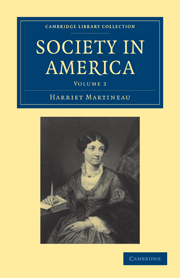CHAPTER III - ADMINISTRATION OF RELIGION
Published online by Cambridge University Press: 29 August 2010
Summary
“What will they then
But force the spirit of grace itself, and bind
His consort Liberty? what but unbuild
His living temples, built by faith to stand,
Their own faith, not another's?”
Milton.“Truth shall spring out of the earth;
And righteousness shall look down from heaven.”
85th Psalm.The inquiry concerning the working of the voluntary system in America,—the only country where it operates without an establishment by its side,—takes two directions. It is asked, first, whether religion is administered sufficiently to the people: and, secondly, what is the character of the clergy.
The first question is easily answered. The eagerness for religious instruction and the means of social worship are so great that funds and buildings are provided wherever society exists. Though the clergy bear a larger proportion to men of other occupations, I believe, than is the case anywhere, except perhaps in the Peninsula, they are too few for the religious wants of the people. Men are wanting; but churches and funds are sufficient. According to a general summary of religious denominations, made in 1835, the number of churches or congregations was 15,477; the population being, exclusive of the slaves, between fifteen and sixteen millions; and a not inconsiderable number being settlers scattered in places too remote for the formation of regular societies, with settled ministers. To these 15,477 churches there were only 12,130 ministers.
- Type
- Chapter
- Information
- Society in America , pp. 271 - 296Publisher: Cambridge University PressPrint publication year: 2009First published in: 1837



